
Cave Hill Cemetery is a 296-acre (1.20 km2) Victorian era National Cemetery and arboretum located at Louisville, Kentucky. Its main entrance is on Baxter Avenue and there is a secondary one on Grinstead Drive. It is the largest cemetery by area and number of burials in Louisville.
The Canton Indian Insane Asylum, aka Hiawatha Insane Asylum, was a federal facility for Native Americans located in Canton, South Dakota, between 1898 and 1934.
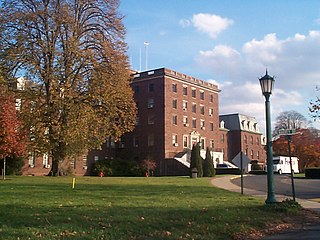
Connecticut Valley Hospital in Middletown, Connecticut, is a public hospital operated by the state of Connecticut to treat people with mental illness. It was historically known as Connecticut General Hospital for the Insane. It is a 100-acre (40 ha) historic district that was listed on the National Register of Historic Places in 1985.

Broughton Hospital is a psychiatric hospital located in Morganton, North Carolina. It is administered by North Carolina Department of Health and Human Services Division of Mental Health, Developmental Disabilities and Substance Abuse Services.

The Bridge Road Cemetery is an historic cemetery on Bridge Road in Eastham, Massachusetts. It is a roughly 1.4-acre (0.57 ha) rectangular parcel on the west side of Bridge Road. The cemetery was established in 1720, and marks the location of the town's second meeting house. It was the second cemetery established in the town, after the Cove Burying Ground. The cemetery was in use from 1720 until the late 1880s; its earliest dated grave is marked 1754. Most of the burials took place between 1770 and about 1830, when a new cemetery was laid out further north. There is a single 20th-century burial, dated 1933.

Wright Cemetery is a historic cemetery on Groton Road near Lynwood Lane in Westford, Massachusetts. The cemetery was formally established in 1836 as a private cemetery for the locally numerous Wright family, although its earliest documented burial dates to 1819. Maintenance and operation of the cemetery was taken over by the town in 1909. The half-acre plot has approximately 150 marked grave sites, and remains in use. The cemetery was added to the National Register of Historic Places in 2005.

Hillside Cemetery, also known as the North Burying Ground, is a historic cemetery on Depot and Nutting Roads in Westford, Massachusetts. The cemetery was established in 1753, and is the burial site of a number of people important in local history. It contains approximately 300 burials, and continues in active use. The cemetery was listed on the National Register of Historic Places in 2005.
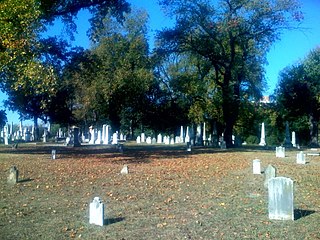
The Shockoe Hill Cemetery is a historic cemetery located on Shockoe Hill in Richmond, Virginia.

The Mechanic Street Cemetery is a historic early cemetery on Mechanic Street in Westfield, Massachusetts. The 4-acre (1.6 ha) cemetery is the city's oldest, with the oldest documented grave dating to 1683. It was used as a burying ground until the late 19th century, although its use began to decline in the middle of the century, with the advent of the popular rural cemetery movement, which was reflected in Westfield with the establishment of the new Pine Hill Cemetery in 1842. No burials were recorded in the 20th century. Although the cemetery has been subjected to some maintenance work, it continues to suffer the effects of vandalism and weather. The cemetery was listed on the National Register of Historic Places in 2002.

The East Main Street Cemetery is a historic cemetery on East Main Street in Dalton, Massachusetts. The cemetery is one of the oldest in the town, with grave markers dating to the 1780s. It was founded on land owned by the Chamberlin family, whose identified graves make up about 20 percent of roughly 250 gravesites. The cemetery was listed on the National Register of Historic Places in 2000.
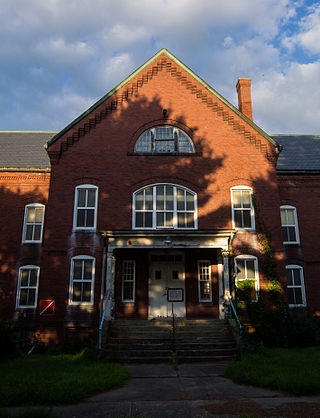
Medfield State Hospital, originally the Medfield Insane Asylum, is a historic former psychiatric hospital complex at 45 Hospital Road in Medfield, Massachusetts, United States. The asylum was established in 1892 as the state's first facility for dealing with chronic mental patients. The college-like campus was designed by William Pitt Wentworth and developed between 1896 and 1914. After an era dominated by asylums built using the Kirkbride Plan, Medfield Insane Asylum was the first asylum built using the new Cottage Plan layout, where instead of holding patients in cells, they would be integrated into a small community and work a specific job. It was formally renamed "Medfield State Hospital" in 1914.

Dennis Village Cemetery, also known as the Common Burying Ground and East Yarmouth Churchyard, is a historic cemetery at Massachusetts Route 6A and Old Bass River Road in the center of Dennis, Massachusetts. The oldest portion, a 2-acre (0.81 ha) parcel, has grave markers dating to 1728, and may contain even older burials. It was established when Dennis was still part of neighboring Yarmouth. Among its notable burials are those of Rev. Josiah Dennis, the namesake of the town, and his wife.
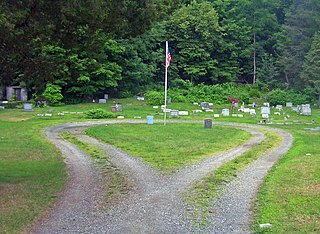
The Old Sloatsburg Cemetery is located at the end of Richard Street in Sloatsburg, New York, United States. It began as the Sloat family cemetery with the burial of Revolutionary War casualty John Sloat in 1781. After a half-century of inactivity, it gradually was expanded to include 1,200 graves by the time of the last burial in 1949.

Kent Burying Ground is a historic cemetery at the corner of Fayette Corner Road and Oak Hill Road in Fayette, Maine. Established in 1880 by Elias Kent, it is unusual for its layout of concentric rings around a central monument, only known in one other cemetery in the state, the Wing Family Cemetery in nearby Wayne. The cemetery was listed on the National Register of Historic Places in 2008.

Ute Cemetery, known as Evergreen Cemetery in the 19th century, is located on Ute Avenue in Aspen, Colorado, United States. It is a small, overgrown parcel with approximately 200 burials. In 2002 it was listed on the National Register of Historic Places.

Bethel Cemetery is a cemetery in rural western Lawrence County, Arkansas. It is located off County Road 225, about 1.1 miles (1.8 km) north of Arkansas Highway 117, roughly midway between Black Rock and Smithville. Its oldest portion occupies a roughly triangular parcel of land, surrounded by a perimeter road, with a gate at the eastern corner. It is located next to the site of a church which was established in the 1820s, and its oldest grave is supposedly the 1835 burial of an American Revolutionary War veteran. The oldest dated grave marker is marked 1858, and the cemetery continues to be used today. The cemetery is a reminder of the community of Denton, which flourished in the mid-19th century, but declined after it was bypassed by the railroad.

Scott Cemetery is a historic cemetery on Arkansas Highway 91 in southeastern Walnut Ridge, Arkansas. It is a 1.5-acre (0.61 ha) parcel roughly rectangular in shape. There are an estimated 101 burials in the cemetery, although only 30 are marked with burial markers. The oldest marked burial dates to the 1910s. It was established as a burying ground by local African-Americans during the Jim Crow era and includes at least eight graves of known former slaves.

Stonington Cemetery is a historic cemetery at North Main Street and United States Route 1 in Stonington, Connecticut. Established as a family cemetery about 1754, it was the first formally incorporated cemetery in New London County, with the incorporation of its association occurring in 1849. Its layout is reflective of changing trends in cemetery organization, from colonial practices to those of the 20th century. It was listed on the National Register of Historic Places in 2018.

The North Acton Cemetery, also known locally as the Forest Cemetery, is a historic cemetery Carlisle Road and North Street in North Acton, Massachusetts. Established no later than 1737, it is one of the town's oldest burial grounds, and remained in active use into the 20th century. It has more than 100 marked graves. The cemetery was listed on the National Register of Historic Places in 2019.
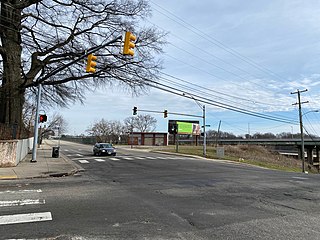
The Shockoe Hill African Burying Ground was established by the city of Richmond, Virginia, for the interment of free people of color, and the enslaved. The heart of this now invisible burying ground is located at 1305 N 5th St.





















